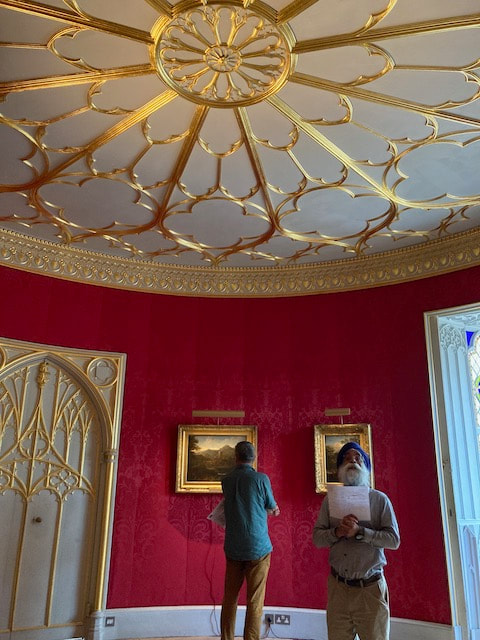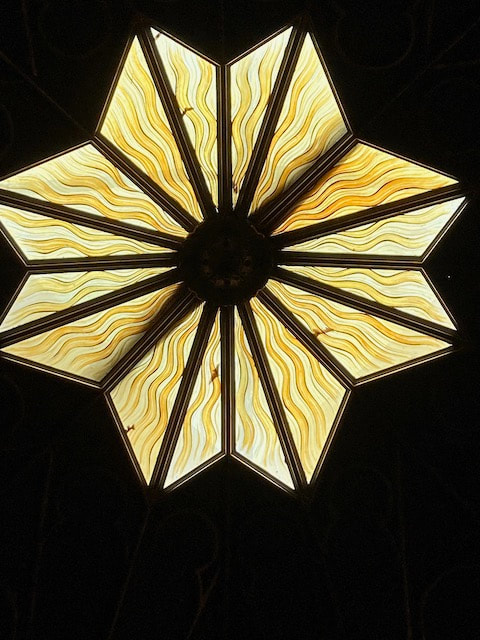|
I have just returned from a fascinating visit to Strawberry Hill, a little gothic castle created in leafy Twickenham by Horace Walpole. The younger son of Robert Walpole, our first Prime Minister, Horace bought a modest house in 1748 and spent the rest of his life extending and remodelling it according to his historical imagination. He wrote that his greatest pleasure in directing operations was the glass: I have amassed such quantities of painted glass, that every window in my castle will be illuminated with it: the adjusting and disposing it is vast amusement. (letter to Horace Mann 1753) This is what comes across - a huge sense of enjoyment and fun, and of a project that just grew and grew. Biblical scenes, tropical birds, heraldic images are displayed throughout the house in magpie mosaics or set amongst bold plain blues and reds. His collection is even collaged to create the impressive lantern, which tells you what is to come as you enter the stairwell. Where did the glass come from? Walpole commissioned an Italian called Asciotti, who was married to a Fleming, to go to Flanders to obtain painted glass. He returned with 450 pieces of glass from the Low Countries, dating from about 1540 to 1660. To add a sense of his own family heritage Walpole also commissioned some armourial glass from William Peckitt. Although the contents of Strawberry Hill were dispersed in the Great Sale of 1842, about half the glass remains and it has been restored in the arrangements that Walpole intended. The fashion for collecting continental glass, which Walpole kick-started, only benefited from the upheavals of the Napoleonic wars in Europe. Although Walpole didn't want to obscure the views from the house - to the river in particular (sadly no longer visible) - he was keen to create the necessary gothic 'conventual gloom' 'which however, when the sun shines is gorgeous, as he appears all crimson and gold and azure thought the painted glass' letter to Horace Mann 1784. Walpole's vision of 'the gothic' is much lighter than versions which followed. My personal favourites amongst the glass are the little celebrations of 17th century dutch life: peasants, burghers, a girl playing a keyboard. They have charm and a lightness of touch, giving little glimpses of affluent Dutch society at the time. The whole house is a delight, as long as you jettison any ideas such as 'truth to materials', as it is all about impression and atmosphere: papier mache imitating stone work, Tudor side chapels being lifted to create fantastical fireplaces. There is whole scale architectural pillaging and repurposing and a huge love of pinnacles. Rouen cathedral, in particular, is ransacked for design ideas, with rose window traceries turned into ceiling designs, for instance. The house was of course extremely influential and more information can be found here. Michael Peover has written an excellent little book about the glass. Finally, it is good to note that while Heritage Crafts has recently put stained glass on its Red List, there has just been a very positive (and hard won) development: the establishment of a new apprenticeship scheme for stained glass makers delivered by Swansea Glass School. This will do something to redress the loss of many practical craft courses in our universities - especially those needing costly resources such as kilns.
0 Comments
|
AuthorI am a glass artist based in Charlbury, Oxfordshire. I work in stained and fused glass. I work to commission and teach stained glass in my studio. I open my studio to visitors during Oxfordshire Artweeks. Archives
July 2023
CategoriesStay in touchTo follow my blog in your favourite browser please click on the RSS Feed button below. You can find me on social media or just subscribe
to my newsletter. |
Copyright © 2015










 RSS Feed
RSS Feed